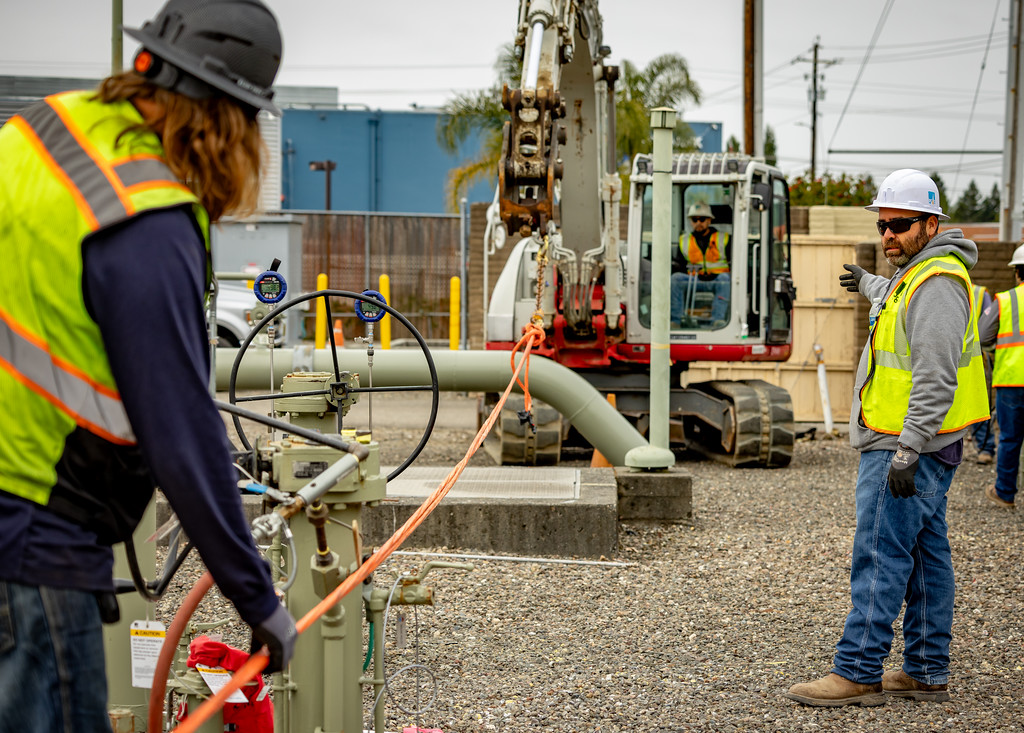
IBEW 1245 members from PG&E prepare to perform an inline inspection on a gas main at the Santa Rosa compressor station.
IBEW 1245 members are responsible for the safe and reliable transmission of natural gas throughout northern and central California’s 6,700 miles of gas transmission pipelines – and a major piece of that responsibility lies in spotting potential problems before they occur. To perform this highly specialized work, IBEW 1245 gas members are uniquely trained to operate incredibly complex pipeline inspection tools.
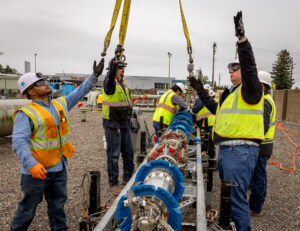 The Utility Reporter recently caught up with an IBEW 1245 Gas Pipeline Operations and Maintenance (GPOM) crew at PG&E’s Santa Rosa Compressor Station, where they were performing an inline inspection on a gas transmission main.
The Utility Reporter recently caught up with an IBEW 1245 Gas Pipeline Operations and Maintenance (GPOM) crew at PG&E’s Santa Rosa Compressor Station, where they were performing an inline inspection on a gas transmission main.
Nineteen-year IBEW 1245 member Autumn Donelson, who works as a Gas Control Tech in the Sonoma Division/North Coast District for PG&E, explained that pipeline inspections involve a series of different tools, each more complex than the last, all designed to root out any potential concerns.
“Today we are launching a MFLC tool,” Donelson explained. “It is the longest, most difficult tool of the group. We’re on our fifth day of tool runs, and I believe this is the ninth tool that we’ve put through the pipe.”
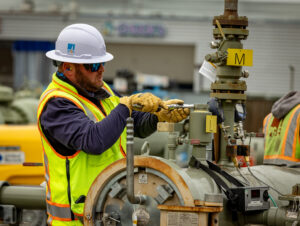 The goal of the testing is to scan the gas transmission pipeline from the inside looking for anomalies. Using magnets and sensors, the multimillion-dollar tool examines the long seam welds and the circumferential welds and can determine the inside dimension of the pipeline, as well as the wall thickness throughout the pipe.
The goal of the testing is to scan the gas transmission pipeline from the inside looking for anomalies. Using magnets and sensors, the multimillion-dollar tool examines the long seam welds and the circumferential welds and can determine the inside dimension of the pipeline, as well as the wall thickness throughout the pipe.
The MFLC tool set off on its long journey from the Santa Rosa compressor station through Healdsburg to Ukiah in a process that would take a little over two hours. To get there, the tool is pushed and pulled with the flow of gas.
“I’m controlling the compressor station right now,” explained Donelson. “I’m pushing at a set pressure and flow, and the ILI (In-Line Inspection) engineering team will be on the phone with me telling me how fast they want it to go. I log into flow meters along the way, and I adjust my facility to match what they need.”
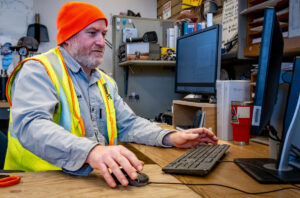
Gas Control Tech Autumn Donelson.
“I’m going to keep it traveling at about five miles per hour,” he added. “Anything more, and it gets to points where it stops or slows down and then speeds up when it frees itself … They don’t have enough time to get all the data when that happens.”
Once the data is collected, it takes a couple of days to get the report back. They can usually spot immediate anomalies or serious problems within two weeks. The report is then sent to the ILI engineering team and a risk team for further analysis.
“They get all the data and tell us where the problems are … they flag those sites, and then that goes to the dig team, and they actually excavate,” Donelson explained. “They put eyes on it and they validate, and then we adjust the pipeline condition based on the problem.”
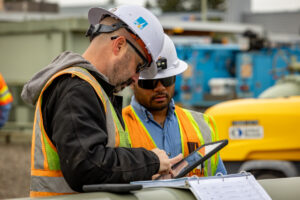 GPOM work requires extensive knowledge and serious attention to detail, and Donelson recognizes the role that IBEW 1245 plays in his crew’s ability to perform their work safely and correctly.
GPOM work requires extensive knowledge and serious attention to detail, and Donelson recognizes the role that IBEW 1245 plays in his crew’s ability to perform their work safely and correctly.
“The union gives us the protection that we need to be able to have a stronger voice and try and get what we deserve … to have somebody to go to fight your fight so that you can continue to work is priceless,” Donelson said. “We are treated well. We are working on some hiccups, but overall, when everybody takes a step back, it’s all a good thing. We’re all in a good position.”
Photos by John Storey